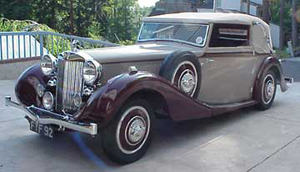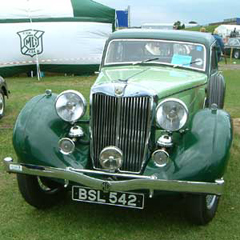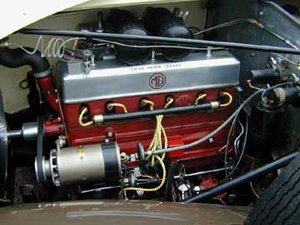The 2.6-Litre MG WA:
“A 2.6-Litre car designed to give high maximum speed, first-class road holding and to reach very high standards of reliability and long life.”
“High-Performance Engine in an improved Type of Chassis Carrying More Capacious Coachwork.”

WA Tickford
The 1938 Motor show saw the introduction of the WA model for MG. A continuation of the SA and VA themes, the WA was larger and more luxuriously appointed, however carried much the same lines and traditions of the previous two models.
The WA looks very similar to the SA and VA models, and if judged, looks like an SA with slightly different trimmings. In fact the WA represents a significant design change. Very little of the car was left untouched. The dissimilarity of components between the SA and WA verifies that the WA was a new design. What was produced was a wonderful car that bettered the SA. Michael Sedgwick (in Cars of the 1930s) described it as ‘an enlarged SA with all the faults ironed out… It could outrun a standard 2.5 Litre Jaguar and give a 3.5 Litre quite a run for its money’. Clearly however, the mark was not met. The Jaguar 3.5 Litre standard was not bettered. The original intention of EX.160 was to meet the market with an equivalent or better car to the Jaguar 3.5 Litre. EX.161, the WA, was a car endeared to many, well engineered and constructed, but could not be considered a market success. Offered at a mere £3 less than the Jaguar and one year late, sales were not brisk with only 358 examples produced before the war stopped production.
Appearance, Design and Production
The 2.6 Litre MG has wonderful lines characterized by the long horizontal bonnet. The radiator was v-fronted which merged with the changed styling of the front wings. A converging curve from each wing met in the middle under the radiator producing a completed, more modern look for the front of the car as compared to the SA 2-Litre model. The large SA round sidelights had been replaced with the octagonal versions from the P type, however all of the other lights remained the same as the SA. Coachwork was also similar to the SA with three body styles available with the Saloon at £442, the four-seater drop head coupe’ at £468, and the open four seater at £450. In production 297 saloons were produced, 52 drophead Tickfords, and 9 tourers.

WA Saloon
The body is larger and the chassis of increased strength and improved design. Due to the increased track width in the rear, an improvement in interior width and elbow room for passengers was obtained.
An entirely new instrument panel differentiates the WA from the SA and VA models interior. The instrument panel of the WA was a new and stylish design arranged so that the large dials of the speedometer and rev counter are high up within easy vision, together with the clock and other dials. Below this panel is a sub-panel with all the minor controls. Interior trim was to a high standard and similar to the styling of the SA and VA.
A secondary fume panel of steel and wood was placed in front of the existing bulkhead, reducing noise, fumes and heat transmitted into the passenger compartment, a common complaint of SA owners.
See the WA Gallery for some original MG factory photos of WAs.
Drivetrain and Mechanicals

WA engine
The engine for the WA is similar to the SA design, but again reapplied and designed. It is rated at 19.82 h.p. or 100 bhp. Six cylinders, 73 X 102mm equating to 2561 cc. The detachable iron cylinder head was machined for higher compression than that of the SA. The block, also of cast iron, finished with an aluminium oil sump of 2 gallon capacity. The counter-balanced crankshaft is mounted in four main bearings.
Twin simi-down draught S.U. Carburetors feed into a hot-spot type straight inlet manifold. One of the most interesting features of this M.G. engine is its lubrication system. Oil is forced round the bearings by a gear pump, but special provision is made for filtering, cooling and rapid warming up from cold. Before the oil is served under pressure to the bearings it has to pass through a long and closely wound coil of copper pipe which is situated inside a water gallery running from end to end of the base of the cylinder water jacket. The exterior of this coil is therefore submerged in the water. When the engine is at work, the cool water from the base of the radiator is fed by the water impeller past the coil on its way to the base of the cylinder jacket, and thereby the oil temperature is prevented from rising undesirably high. But when the engine is cold and is started up, the automatic thermostat control is short circuiting the radiator in order that the water in the cylinder jackets shall warms up as rapidly as possible, and this being so, the coil of the copper tube of the oil system is warmed up rapidly with the water.
The wet clutch from the SA was replaced by a dry plate as now fitted to the VA. It was a ventilated Borg and beck clutch coupled with a four speed gear box that had synchromesh on second, third and top.
The chassis frame of the WA is a boxed welded steel construction. Box sections are used throughout. The Frame of the WA was strengthened over the SA design to in consideration of the additional 300 lb load, and also incorporated the increased width. The wheel base of the car is 10 ft. 3 in., the front track 4ft 5in and the rear 4 ft. 8 3/8in.
Steering incorporated the Bishop cam gear, with a medium ratio, a steering column adjustable for length.
Lockheed hydraulic brakes are fitted and have twin master cylinders giving independent balanced operation between front and rear. The brake drums are 14 in. in diameter
At the rear of the chassis is a 16 gallon fuel tank. A gauge on the instrument panel show petrol contents, and alternatively the level of oil in the engine sump when a button is pressed.
The Jackall hydraulic jack system was standard equipment. This system allows the fore, aft, or entire car to be raised from inside the car.
The headlamp system is arranged so that a foot switches cuts off the head lamps and brings on a pass light mounted in the centre of the front bumper.
Conclusion
The WA was a superb car introduced into a difficult and competitive market. It was a high standard car, luxuriously fitted and well built, that performed not as a sports car but as a solid precise road car.
